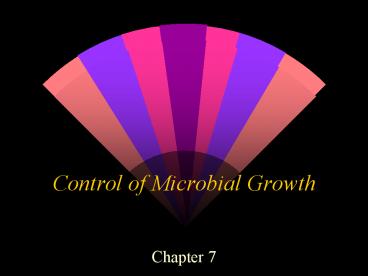Control of Microbial Growth - PowerPoint PPT Presentation
1 / 29
Title:
Control of Microbial Growth
Description:
Yersinia pestis Gram (-) rod. 2 Vectors. Rat. Flea. Yersinia pestis - Gram (-) bacillus ... 3. Hot Air Sterilization. Oven ( 170 C for 2 hours) ... – PowerPoint PPT presentation
Number of Views:86
Avg rating:3.0/5.0
Title: Control of Microbial Growth
1
Control of Microbial Growth
- Chapter 7
2
History
- Humans vs. Microbes
- infections
- diseases
- plagues
- epidemics
- pandemics
3
Nursery Rhyme
Ring- a - ring of rosies Pocketful of
posies Achoo ! Achoo ! We all fall down.
4
Bubonic Plague or the Black Death
- Epidemic swept thru Europe in the Middle Ages
(13th and 14th centuries) - 40 million people were killed
- About 1/3 of the population of the continent
- Etiological agent
- Yersinia pestis Gram (-) rod
- 2 Vectors
- Rat
- Flea
5
Yersinia pestis - Gram (-) bacillus Vectors -
Rat and Flea
6
Bubonic Plague Infection
- 1. Flea bite with Yersinia pestis
- 2. Bacteria multiply in the bloodstream
- Bacteremia
- 3. Bacteria localize in lymph nodes, especially
axillary and groin areas
7
4. Hemorrhaging occurs in lymph nodes, resulting
in black and blue swellings or Buboes (hence
the name Bubonic Plague or Black Death)
8
Bubonic Plague Infection
- 5. If untreated, about 50 Mortality Rate
- 6. If bacteria spread to the lungs, it becomes
Pneumonic Plague and is now highly contagious
(Almost a 99 Mortality Rate)
9
Nursery Rhyme
Ring - a - ring of rosies, A pocketful of
posies Achoo ! Achoo ! We all fall down.
10
I wouldnt touch it with a 10
pole
11
Humans vs. Microbes
- 1. Most of History, microbes have been winning
the battle - 2. In the last 100 yrs or so the battle has swung
in our favor - Why?
- Because of our increasing knowledge of how to
Control Microbial Growth
12
Smallpox
Variola virus Eradicated in
1977 (Somalia)
13
Methods to Control Microbial Growth
- 1. Physical
- 2. Chemical
14
Terms used
- Sterilization vs. Disinfection
- Sterilization
- destroying all forms of life
- Disinfection
- destroying pathogens or unwanted organisms
15
- Disinfectant vs. Antiseptic
- Disinfectant
- antimicrobial agent used on inanimate objects
- Antiseptic
- antimicrobial agent used on living tissue
16
cidal vs. static
- Bactericidal - kills bacteria
- Bacteristatic - inhibits bacterial growth
- Fungicidal
- Fungistatic
- Algacidal
- Algastatic
17
Factors that effect Antimicrobial Activity
- 1. Temp
- 2. Time
- 3. Concentration of Antimicrobial agent
- 4. Type of Microbe
- 5. Activity of Microbe
- 6. Presence of organic matter
18
Targets of Antimicrobial Agents
- 1. Cell membrane
- 2. Enzymes Proteins
- 3. DNA RNA
19
Physical Methods of Microbial Control
- 1. Heat
- works by denaturing enzymes and proteins
- A. Thermal Death Point (TDP)
- lowest temp. at which all microorganism in a
liquid culture are killed in 10 minutes - B. Thermal Death Time (TDT)
- minimum length of time in which all
microorganisms in a liquid culture are killed at
a given temperature
20
Moist Heat
- 1. Boiling Water
- kills vegetative bacterial cells, Fungi and many
viruses - not effective for endospores and some viruses
- Hepititis (20 min)
- Some spores may survive boiling water for up to
20 hrs
21
Moist Heat
- 2. Autoclave (Steam under pressure)
- preferred method of sterilization
- Water boils at 100 C
- Increasing the pressure raises the Temp.
- 15 lbs./ per sq. inch (psi) ------gt 121 C
- 121 C for 15 min.
22
Kilit Ampule
- Spores of Bacillus stearothermophilus
- fermentable sugar
- pH indicator
- basic - red
- acid - yellow
23
Dry Heat
- 1. Direct Flaming
- Inoculating Loop and Needle 100 effective
- 2. Incineration
- disposable wastes (paper cups, bags, dressings)
- 3. Hot Air Sterilization
- Oven ( 170 C for 2 hours)
- used on substances that would be damaged by moist
heat sterilization - gauzes, dressings or powders
24
Filtration
- Removes microorganisms from solutions that might
be damaged by heat - culture media
- enzymes
- vaccines
- antibiotics
25
Radiation
- 1. Ionizing Radiation
- gamma rays x-rays
- penetrates most substances
- Used on substances that could be damaged by heat
- plastic petri dishes
- plastic syringes
- catheters
- surgical gloves
26
Radiation
- 2. Non-Ionizing Radiation
- UV Light
- does not penetrate plastic, glass or
proteinaceous matter - Used to reduce microbial populations
- hospital rooms
- nurseries
- operating rooms
Thymine Dimers
27
Pasteurization
- Disinfection - not sterilization (removes
unwanted organisms) - Mycobacterium tuberculosis
- 63 C for 30 minutes
- 72 C for 15 seconds (HTST)
- Thermodurics
- able to survive high temps.
28
Methods used to control Microbial Growth
- 1. Heat
- Moist Heat
- Boiling Water
- Steam Heat (Autoclave)
- Dry Heat
- Direct Flaming
- Incineration
- Hot Air Sterilization (Oven)
- 2. Filtration
- 3. Radiation
- Ionizing Radiation
- Non-Ionizing Radiation
- 4. Pasteurization (Heat)
29
(No Transcript)































